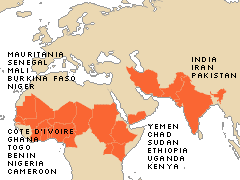
How do we know
Data about the prevalence of guinea worm disease was provided through an innovative, village-based monthly reporting system pioneered by the campaign. A cost-benefit analysis was prepared by the Africa Human Development Department at the World Bank.Downloads
- Read the entire case study
(PDF | 147 K)
External Links
- Read about the Carter Center's efforts to eradicate guinea worm
- View a PBS interactive feature on guinea worm
- Read a first hand account of guinea worm
- Read a Q & A with Carter Center guinea worm experts
- Watch a video on Guinea Worm Disease Eradication
- Watch another video with President Carter and Dr. Hopkins
Health Condition: In 2005, fewer than 11,000 cases of Guinea worm were reported in the nine remaining endemic countries. Just three countries have reported more than 1,000 cases - and the vast majority of the cases are in Sudan, where civil war has impeded progress. Before the start of the campaign in 1986, an estimated 3.5 million people in 18 endemic countries in Africa and Asia were infected with Guinea worm, and 120 million were at risk.
Intervention or Program: With the technical and financial support of the a global coalition of organizations led by the Carter Center, the United Nations Children’s Fund, the US Centers for Disease Control and Prevention, and the World Health Organization, 20 countries implemented national Guinea Worm Eradication Programs, run through the ministries of health. The primary interventions of the campaign include:
- the provision of safe water (through deep well digging, applying larvicide, and purifying water through cloth filters);
- health education;
- case containment, management, and surveillance.
Impact: The eradication efforts have led to a 99.7 percent drop in Guinea worm prevalence. In 2005, fewer than 11,000 cases were reported, compared with an estimated 3.5 million infected people in 1986. By 1998, the campaign prevented between 9 million and 13 million cases of Guinea worm. As of 2005, the campaign has prevented more than 63 million cases of Guinea worm disease, reduced the number of endemic villages by 91 percent, and stopped the transmission of the disease in 11 of the 20 endemic countries.
Cost and Cost-Effectiveness: The total cost of the program between 1986 and 1998 was $87.4 million. The estimated cost per case was $5 to $8. The World Bank determined that the campaign has been highly cost-effective and cost-beneficial. The economic rate of return based on agricultural productivity alone has been estimated at 29 percent. The estimated cumulative cost of the campaign as of 2004 was approximately $125 million.

